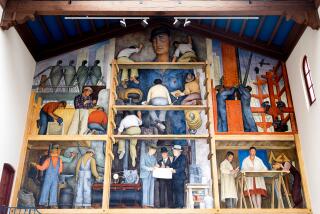Missing art is a honey of a mystery
- Share via
It’s a tale every bit as intriguing as “The Story of Goldilocks and the Three Bears.” In fact, the biggest mystery now under discussion at the new $16-million Monrovia Public Library is, “Where is Mama Bear?”
Historians in the city 24 miles northeast of Los Angeles hope to reunite a 70-year-old mural depicting four baby grizzly bears with a missing companion painting that shows their watchful mother gazing at them proudly -- and protectively.
Renowned West Coast modernist artist Helen Katherine Forbes painted the two murals for the Monrovia post office in 1940 under the auspices of a Depression-era federal art project. The bears were removed by the U.S. Postal Service in a 1964 remodeling project.
In 2004, local historians discovered that the painting of the four baby bears had been rolled up and forgotten in the post office basement. After professional restoration, it was hung prominently in the library’s Heritage Room.
The mother bear painting was nowhere to be found, however, and rumors of its whereabouts have been pawed over ever since.
Bears have played a big role in Monrovia. Residents have given some bears names and nine years ago, they voted to approve $9.5 million for the creation of a wilderness preserve to protect a local wildlife corridor that’s busy with bear traffic.
A giant statue of a bear stands guard over Monrovia Canyon Park’s Nature Center. The sculpture honors the city’s most famous visitor, Samson the Hot Tub Bear. Samson took a liking to suburban life, often relaxing in residential hot tubs. When he became ill from ingesting a plastic bag, he was captured and marked for death until public pressure prompted the Orange County Zoo to take him in. He lived there -- with his own hot tub -- until his death from old age in 2001.
“They embrace their bears here, this being the home of Samson,” said Walt Shelly. He’s a 78-year-old retired graphics designer turned amateur historian responsible for uncovering the four bears mural.
His family moved to Monrovia in 1939 and Shelly remembers when Forbes’ five bears were hung in the post office.
“The fur she painted looked so real. As a kid I wanted so much to touch it,” he said.
They were out of reach, however. The four cubs stretched about 16 feet over the three bronze-grated windows designated money orders, postal savings and “registered & COD” mail. A large air vent poked through the middle of the artwork. The 4-foot-wide painting of the mother bear was hung over the postmaster’s door.
The paintings were done “Chinese style,” as The Times reported in 1940. Forbes used egg tempera, a mixture of egg yolks and powdered colors “used by the ancient Chinese and Egyptians. The resultant colors practically last forever, unlike many modern ‘improved’ media,” The Times said.
Shelly was inspired to recruit friend Clinton Arsenault, a 67-year-old retired salesman, and begin a search for the post office bears after reading a 2003 Times story about efforts to preserve Depression-era public artwork in Chicago.
The two of them researched the history of the Monrovia murals and prepared a report for city officials and got the Monrovia Historic Preservation Group involved. Locally generated funding paid the $26,000 restoration cost and postal officials agreed to let the city display the painting in the new library under a renewable 25-year contract.
A high-profile San Francisco artist, Forbes used a grizzly in the San Francisco Zoo as the model for her Monrovia work. She died in 1945 at the age of 52.
Shelly and Arsenault say they have seen a 1965 video shot in the postmaster’s office of another Monrovia iconoclast, muckraking author and political activist Upton Sinclair. The mural, already removed from the wall, is shown atop a file cabinet as the camera pans the room. The video proves that the mother bear was removed in one piece. “It looks in pretty good shape,” Shelly said.
Word in Monrovia is that the mother bear painting was shipped to some “historic Washington museum” a year after the video was shot. But some suggest it could be in a resident’s garage. Shelly said he’s determined to get it back.
“We were thinking of putting wanted signs on telephone poles around here: ‘Have you seen this bear?’ ” he said.
--
More to Read
Sign up for Essential California
The most important California stories and recommendations in your inbox every morning.
You may occasionally receive promotional content from the Los Angeles Times.











